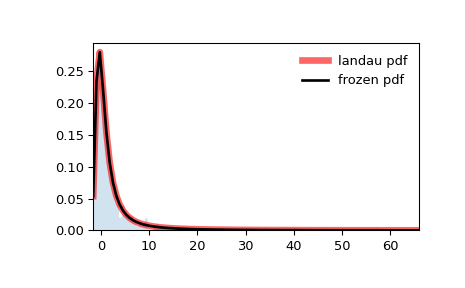scipy.stats.landau#
- scipy.stats.landau = <scipy.stats._continuous_distns.landau_gen object>[source]#
A Landau continuous random variable.
As an instance of the
rv_continuousclass,landauobject inherits from it a collection of generic methods (see below for the full list), and completes them with details specific for this particular distribution.Methods
rvs(loc=0, scale=1, size=1, random_state=None)
Random variates.
pdf(x, loc=0, scale=1)
Probability density function.
logpdf(x, loc=0, scale=1)
Log of the probability density function.
cdf(x, loc=0, scale=1)
Cumulative distribution function.
logcdf(x, loc=0, scale=1)
Log of the cumulative distribution function.
sf(x, loc=0, scale=1)
Survival function (also defined as
1 - cdf, but sf is sometimes more accurate).logsf(x, loc=0, scale=1)
Log of the survival function.
ppf(q, loc=0, scale=1)
Percent point function (inverse of
cdf— percentiles).isf(q, loc=0, scale=1)
Inverse survival function (inverse of
sf).moment(order, loc=0, scale=1)
Non-central moment of the specified order.
stats(loc=0, scale=1, moments=’mv’)
Mean(‘m’), variance(‘v’), skew(‘s’), and/or kurtosis(‘k’).
entropy(loc=0, scale=1)
(Differential) entropy of the RV.
fit(data)
Parameter estimates for generic data. See scipy.stats.rv_continuous.fit for detailed documentation of the keyword arguments.
expect(func, args=(), loc=0, scale=1, lb=None, ub=None, conditional=False, **kwds)
Expected value of a function (of one argument) with respect to the distribution.
median(loc=0, scale=1)
Median of the distribution.
mean(loc=0, scale=1)
Mean of the distribution.
var(loc=0, scale=1)
Variance of the distribution.
std(loc=0, scale=1)
Standard deviation of the distribution.
interval(confidence, loc=0, scale=1)
Confidence interval with equal areas around the median.
Notes
The probability density function for
landau([1], [2]) is:\[f(x) = \frac{1}{\pi}\int_0^\infty \exp(-t \log t - xt)\sin(\pi t) dt\]for a real number \(x\).
The probability density above is defined in the “standardized” form. To shift and/or scale the distribution use the
locandscaleparameters. Specifically,landau.pdf(x, loc, scale)is identically equivalent tolandau.pdf(y) / scalewithy = (x - loc) / scale. Note that shifting the location of a distribution does not make it a “noncentral” distribution; noncentral generalizations of some distributions are available in separate classes.Often (e.g. [2]), the Landau distribution is parameterized in terms of a location parameter \(\mu\) and scale parameter \(c\), the latter of which also introduces a location shift. If
muandcare used to represent these parameters, this corresponds with SciPy’s parameterization withloc = mu + 2*c / np.pi * np.log(c)andscale = c.This distribution uses routines from the Boost Math C++ library for the computation of the
pdf,cdf,ppf,sfandisfmethods. [1]References
[1] (1,2)Landau, L. (1944). “On the energy loss of fast particles by ionization”. J. Phys. (USSR). 8: 201.
[3]Chambers, J. M., Mallows, C. L., & Stuck, B. (1976). “A method for simulating stable random variables.” Journal of the American Statistical Association, 71(354), 340-344.
[4]The Boost Developers. “Boost C++ Libraries”. https://www.boost.org/.
[5]Yoshimura, T. “Numerical Evaluation and High Precision Approximation Formula for Landau Distribution”. DOI:10.36227/techrxiv.171822215.53612870/v2
Examples
>>> import numpy as np >>> from scipy.stats import landau >>> import matplotlib.pyplot as plt >>> fig, ax = plt.subplots(1, 1)
Get the support:
>>> lb, ub = landau.support()
Calculate the first four moments:
>>> mean, var, skew, kurt = landau.stats(moments='mvsk')
Display the probability density function (
pdf):>>> x = np.linspace(landau.ppf(0.01), ... landau.ppf(0.99), 100) >>> ax.plot(x, landau.pdf(x), ... 'r-', lw=5, alpha=0.6, label='landau pdf')
Alternatively, the distribution object can be called (as a function) to fix the shape, location and scale parameters. This returns a “frozen” RV object holding the given parameters fixed.
Freeze the distribution and display the frozen
pdf:>>> rv = landau() >>> ax.plot(x, rv.pdf(x), 'k-', lw=2, label='frozen pdf')
Check accuracy of
cdfandppf:>>> vals = landau.ppf([0.001, 0.5, 0.999]) >>> np.allclose([0.001, 0.5, 0.999], landau.cdf(vals)) True
Generate random numbers:
>>> r = landau.rvs(size=1000)
And compare the histogram:
>>> ax.hist(r, density=True, bins='auto', histtype='stepfilled', alpha=0.2) >>> ax.set_xlim([x[0], x[-1]]) >>> ax.legend(loc='best', frameon=False) >>> plt.show()
